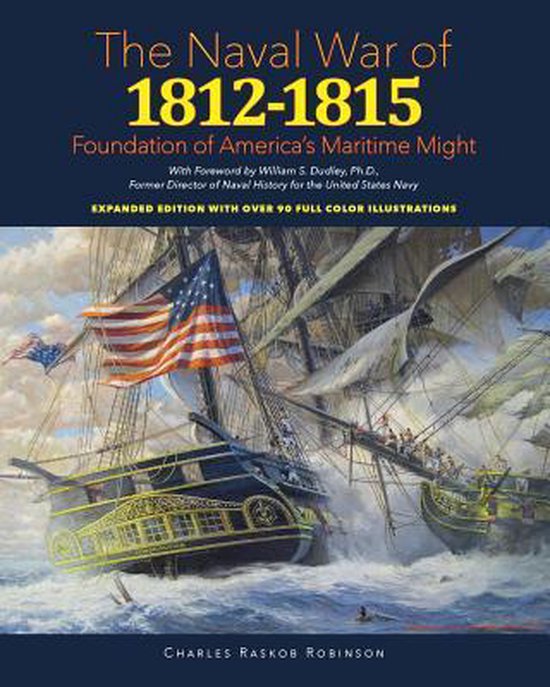Naval War of 1812 - 1815 Foundation of America's Maritime Might
Afbeeldingen
Artikel vergelijken
Uitgever: Createspace Independent Publishing Platform
- Engels
- Paperback
- 9781507638361
- 02 april 2015
- 144 pagina's
Samenvatting
This is the exciting story about how the young American Republic established the United States Navy, Marine Corps and Revenue Cutter Service (the predecessor to the Coast Guard), designed and built the most powerful class of frigate in the world, trained its seamen in gunnery and naval warfare and gained battle experience in the Quasi-War with France in 1798-1800 and the Barbary War (“Shores of Tripoli”) in 1801-1805. The United States was a neutral nation in a world where European powers were locked in a death struggle. When it could no longer tolerate interference with its maritime commerce and the impressment of its sailors into the Royal Navy, it declared war against Great Britain in the “Second War of Independence” in 1812. Lessons learned then are still relevant in today’s very uncertain world. In this era of fighting sail when ships were made of wood and men of iron, the narrator takes us into the action of the three principal theaters of the conflict: The war on blue water of the Atlantic, Pacific and Indian Oceans; the war on the lakes along the northern border with British North America (Canada); and the war on brown water of American bays, sounds, estuaries and rivers from Maine to New Orleans. Each chapter bristles with action. On blue water the young Navy, with less than two-dozen ships, took on the mightiest, the Royal Navy, with a fleet of over 600. To the world’s amazement, in the first eight months of the war five single-ship actions occurred and in every one the Americans bested the British. The names ring through history: The American “heavy frigate” Constitution (“Old Ironsides” – the oldest commissioned ship in the world still afloat) and the smaller frigates Chesapeake, Constellation and Essex (which first made the United States a two-ocean Navy as it preyed on the British in the Pacific) and smaller warships, Enterprise, Wasp, Hornet, and Argus. British ships also left their mark on history: Guerriere, Macedonian, Java, Shannon, Phoebe, Endymion, Orpheus, Borer, the 74–gun Ramillies and many more. As the wars in Europe ended, the British turned to deal with the troublesome Americans and blockaded the entire country, causing near economic collapse. And yet daring crews still ran the blockade and fast American privateers continued to harass. In the war on the lakes, the British North Americans thwarted American attempts to invade Canada and began to attack American territory. Over time, it was the dramatic struggle by both sides to build and man inland navies that dictated the outcome: the American victory at the Battle of Lake Erie and the following British defeat in the Battle of the Thames where the great Native American leader and ally of the British, Tecumseh, died. However, many battles and actions preceded these events: Sacket’s Harbor, Kingston, Fort George, the Burning of York, the “Burlington Races,” Stoney Creek, Chateauquay, and Crysler’s Farm. Subsequently, the decisive victory by the American Navy at the Battle of Lake Champlain brought northern action to a close. In the final theater, brown water, the British captured eastern Maine, harassed Long Island Sound shipping including the Burning the Fleet in Essex, CT, and Bombarding Stonington, CT, and were very active in the Chesapeake Bay including the Burning of the Capitol, the Battle of Baltimore, Bombardment of Ft. McHenry where the National Anthem was penned. Brown water concludes with the British attack on Mobile and New Orleans where the very colorful and charismatic American, Andrew Jackson, delivered the final victory of the war. The Epilogue shows how the war provided the foundation for the strength of American maritime services over the following two hundred years. In the words of the current Secretary of the Navy Ray Mabus: “(In the future) whatever unknown seas this still young and expanding nation will have sailed, our maritime services will still recognize their voyage began, in earnest, in the War of 1812.”
Productspecificaties
Wij vonden geen specificaties voor jouw zoekopdracht '{SEARCH}'.
Inhoud
- Taal
- en
- Bindwijze
- Paperback
- Oorspronkelijke releasedatum
- 02 april 2015
- Aantal pagina's
- 144
- Illustraties
- Nee
Betrokkenen
- Hoofdauteur
- Charles Raskob Robinson
- Tweede Auteur
- Charles Raskob Robinson
- Hoofduitgeverij
- Createspace Independent Publishing Platform
Overige kenmerken
- Extra groot lettertype
- Nee
- Product breedte
- 203 mm
- Product hoogte
- 13 mm
- Product lengte
- 254 mm
- Studieboek
- Ja
- Verpakking breedte
- 203 mm
- Verpakking hoogte
- 9 mm
- Verpakking lengte
- 254 mm
- Verpakkingsgewicht
- 408 g
EAN
- EAN
- 9781507638361
Je vindt dit artikel in
- Categorieën
- Taal
- Engels
- Boek, ebook of luisterboek?
- Boek
- Studieboek of algemeen
- Algemene boeken
- Periode
- 19e eeuw
Kies gewenste uitvoering
Bindwijze
: Paperback
Prijsinformatie en bestellen
Rapporteer dit artikel
Je wilt melding doen van illegale inhoud over dit artikel:
- Ik wil melding doen als klant
- Ik wil melding doen als autoriteit of trusted flagger
- Ik wil melding doen als partner
- Ik wil melding doen als merkhouder
Geen klant, autoriteit, trusted flagger, merkhouder of partner? Gebruik dan onderstaande link om melding te doen.

